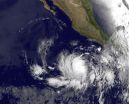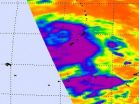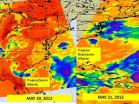(Press-News.org) A special feature in this week's issue of the journal Science highlights protein array technology, touching on research conducted by Joshua LaBaer, director of the Biodesign Institute's Virginia G. Piper Center for Personalized Diagnostics.
With the successful completion of the Human Genome Project, research attention is increasingly focusing on proteins. Versatile products produced from genetic templates, proteins are principle actors in both the maintenance of health and the onset of illness. Protein microarrays are a means of bridging the gap between analysis of the nucleotide sequences that make up DNA and the proteome—the universe of proteins built from the amino acids coded for by genes.
Protein microarrays are helping researchers develop early detection methods, particularly for chronic diseases, which account for most of the country's health care expenditures. Identifying telltale signs of diabetes, coronary artery disease, congestive heart failure and various cancers at an early, pre-symptomatic stage, offers the best prognosis for successful treatment, at dramatically reduced cost.
"Proteins are the machines of biology. Disease is nearly always a result of protein malfunction, and most drugs are designed to affect protein function. Protein microarrays enable us to test the biochemical properties of thousands of proteins simultaneously," says LaBaer.
While the genome provides the instruction manual for building living systems, proteins are the real molecular workhorses, faithfully carrying out genomic instructions, while also modifying their behavior under myriad environmental influences. Proteins provide structure to cells and tissues, facilitate signaling within and between cells, act as receptors, catalyze enzymatic activity, execute immune functions, and perform countless other biological tasks.
A more thorough understanding of the proteome is therefore vital to diagnostic medicine, particularly for establishing biomarkers—pre-symptomatic indices of early disease states, detectable as protein components in blood. LaBaer's group is working on discovering biomarkers for a range of deadly illnesses, including, breast, ovarian, lung and oropharyngeal cancers; type I diabetes and assorted infectious pathogens.
Until recently, studying the complexities of proteins, (as opposed to the sequence of four nucleotides making up DNA), has been daunting. A protein microarray usually consists of a library of proteins immobilized on a glass slide or chip in a 2D addressable grid format. Arrays of this sort are made by expressing and painstakingly purifying proteins, then imprinting them onto the slide's surface. Once a library of proteins has been splayed out on an array, high-throughput methods can be used to investigate their behavior.
Similar arrays have long been used to study DNA, yielding a steady stream of insights into the genome and in some cases providing rapid and accurate diagnostic tools. Researchers would like to repeat the successes of DNA microarrays with protein microarray technology, though a number of hurdles exist. Compared with nucleic acids, proteins exhibit enormous structural diversity and complexity. The synthesis, stabilization and purification of proteins are often laborious undertakings. Adequately attaching proteins to the array surface is tricky and subsequent detection of these proteins through binding events is considerably more complex than in the case of nucleic acid arrays.
Protein microarrays can be broken down into two broad categories. With so-called forward phase arrays, one protein sample is screened against multiple reagents. The capture protein—usually an antibody— is first affixed to the slide surface. The immobilized antibody can then be used to capture antigens it recognizes when a test sample is spread over the array. The test sample could be blood, cells, cell lysates, or some other biological specimen. The captured analyte can then be detected directly, using a fluorescent dye. The technique offers high specificity, but is time consuming.
In reverse phase arrays, the test sample is printed directly on the slide and the array is then detected with a dye-conjugated protein, such as an antibody. One of the key advantages of the reverse phase microarray is a reduction in the number of antibody probes needed to detect a protein antigen. Examples of both forward and reverse arrays are presented in the current Science review.
LaBaer's group works with a novel protein array, designed in their lab. Known as Nucleic Acid Programmable Protein Array or NAPPA, the technique is particularly powerful because it obviates the need to purify proteins prior to their use in a microarray. Instead of using the protein itself, the NAPPA technique spots protein-coding circular pieces of DNA known as plasmids —the blueprints for building proteins—onto slides, bringing the simplicity and low cost of DNA microarray technology into the world of proteomics.
Immediately prior to the use of the array, an in vitro transcription/translation system is applied as a coating on the slide, turning each array into a nanoscale factory for protein production. Issues of protein stability and purification are avoided, as proteins are synthesized immediately prior to use. (Figure 1 shows a schematic of how NAPPA works.)
"The central concept for NAPPA is to make the proteins 'fresh' only moments before testing them and to use the machinery most relevant to the proteins to make them. Currently we are using human ribosomal machinery to make human proteins," LaBaer says.
LaBaer's method currently allows some 2300 genes to be arrayed on a conventional microscope slide. Given the vastness of the human proteome, comprised of more than 30,000 distinct proteins, the technique requires around 10 array slides to fully sample the proteome. Spotting DNA plasmids at higher densities requires new imprinting techniques to avoid chemical cross talk between closely situated array spots. Using advanced piezoelectric-pipetting technology, the group anticipates next generation protein arrays that will improve protein densities per slide by roughly an order of magnitude.
Currently, at the Piper Center's state of the art facility, some 14,000 human proteins are employed in an array in order to detect antibody targets of disease. The technique is being used to investigate posttranslational modifications to proteins and for the identification of novel autoantibodies.
Post-translational changes can occur during or after protein synthesis, resulting in modifications to protein residues. Such changes alter physical and chemical properties affecting protein shape and function. The presence of particular autoantibodies may signal presymptomatic recognition of disease antigens, for example those produced by cancerous tumors. One recent study identified a panel of 28 antigens that can pinpoint early onset breast cancer in blood sera with 80 to 100 percent specificity.
In addition, this research may help speed more effective vaccines to market by identifying immunogenic proteins associated with infectious diseases like cholera, anthrax and Pseudomonas aeruginosa.
"The key to this work," according top LaBaer, "is to test many patients and many healthy indviduals to determine which responses are specifically found only in the patients. Most important is to confirm these findings in independent experiments. "
INFORMATION:
Array of light for early disease detection?
2012-05-23
ELSE PRESS RELEASES FROM THIS DATE:
NASA Sees Eastern Pacific's Second Tropical Storm Form
2012-05-23
On May 21, NASA satellites were monitoring Tropical Depression 02E in the eastern Pacific Ocean, and 24 hours later it strengthened into the second tropical storm of the season. Tropical Storm Bud was captured by NOAA's GOES-13 satellite on May 22, and appears to be well-formed.
Tropical Storm Bud isn't going to stop there, however. According to the forecasters at the National Hurricane Center, Bud is expected to become a hurricane because of light to moderate wind shear and warm sea surface temperatures.
On May 22 at 0900 UTC (2 a.m. PDT/5 a.m. EDT), Tropical Storm ...
NASA satellite sees Tropical Storm Sanvu pass Guam, strengthen
2012-05-23
Tropical Depression 03W in the western North Pacific did exactly what forecasters expected over the last twenty-four hours: it became a tropical storm named Sanvu and passed west of Guam on a northwesterly track.
On May 22 at 0900 UTC (5 a.m. EDT), Tropical Storm Sanvu was more than 100 miles west-northwest of Andersen Air Force Base, Guam, and still over 600 nautical miles south of Iwo To, Japan and headed in that direction. Sanvu's center was located near 15.2 North and 141.9. East. It was still churning up rough surf around Guam. Sanvu has maximum sustained winds near ...
Barrow researchers use magic for discoveries
2012-05-23
(Phoenix, AZ May 22, 2012) -- Researchers at Barrow Neurological Institute at St. Joseph's Hospital and Medical Center have unveiled how and why the public perceives some magic tricks in recent studies that could have real-world implications in military tactics, marketing and sports.
Susana Martinez-Conde, PhD, of Barrow's Laboratory of Visual Neuroscience, and Stephen Macknik, PhD, of Barrow's Laboratory of Behavioral Neurophysiology are well known for their research into magic and illusions. Their most recent original research projects, published in Frontiers in Human ...
Alberto now a tropical depression, seen by NASA
2012-05-23
Infrared satellite imagery from NASA's Aqua satellite revealed Alberto weakened from a tropical storm to a tropical depression as it appears more disorganized. At 10:30 a.m. EDT on May 21, Tropical Storm Alberto weakened to a tropical depression, and has maintained that status today, May 22.
As of 5 a.m. EDT on May 22, Alberto's maximum sustained winds were near 35 mph (55 kph) but he is expected to weaken in 24 hours. Alberto was centered about 220 miles south of Cape Hatteras, North Carolina, near 32.0 North and 75.5 West. Alberto was moving to the northeast near 15 ...
Cleft lip/palate cause much more than cosmetic problems
2012-05-23
MAYWOOD, Ill. -- Children born with cleft lip, cleft palate and other craniofacial disorders face numerous medical challenges beyond appearance.
Patients can face serious airway, feeding, speech and hearing problems, as well as social and psychological challenges, Laura Swibel Rosenthal, MD, of Loyola University Medical Center and colleagues write in the June 2012 issue of Otolaryngologic Clinics of North America.
"The management of patients with craniofacial syndromes is complex," Rosenthal and colleagues write. "Otolaryngologic [ear-nose-throat] evaluation is of paramount ...
Scientists start explaining Fat Bastard's vicious cycle
2012-05-23
This press release is available in French.
VIDEO:
Stephanie Fulton of Université de Montréal and its affiliated research hospital studies the behavior of mice and their brain chemistry to reveal how humans may act in similar circumstances.
Click here for more information.
Fat Bastard's revelation "I eat because I'm depressed and I'm depressed because I eat" in the Austin Powers ...
Weight loss improves SBD and metabolic dysregulation in obese children
2012-05-23
ATS 2012, SAN FRANCISCO –Weight loss improved both metabolic parameters and sleep-disordered breathing (SDB) in obese children in a new study from researchers in Belgium, confirming links between metabolic dysregulation, SDB and obesity.
"SDB is highly prevalent in childhood obesity, and may be a risk factor for the metabolic syndrome. In our population of 224 obese children and adolescents, 30% had SDB, which was significantly correlated with metabolic parameters, including aspartate aminotransferase (ASAT), alanine aminotransferase (ALAT) and HDL cholesterol at baseline," ...
Severity of sleep disordered breathing predicts glycemic health
2012-05-23
ATS 2012, SAN FRANCISCO –The severity of sleep disordered breathing and nocturnal hypoxemia independently predict both glycosylated hemoglobin (HbA1c) levels and type 2 diabetes mellitus (T2DM), according to a new study.
"Because people with obstructive sleep apnea syndrome (OSAS) are often overweight or obese it has been difficult to interpret earlier studies of the relationship between sleep disordered breathing and metabolic disorders," said Brian Kent, MBBCh, research fellow at St. Vincent's University Hospital in Dublin. "We found that obstructive sleep apnea syndrome ...
Oniqua Announces Major Enhancements to Material and Catalog Standards Database Solution
2012-05-23
Oniqua MRO Analytics (www.oniqua.com), the leading provider of analytics-based MRO optimization solutions for asset-intensive organizations, today announced significant enhancements to its Oniqua Standards Dictionary (OSD) database solution.
Available on an online subscription basis, OSD is a comprehensive material and catalog standards environment specifically designed, built and optimized for asset-intensive industries.
OSD 3.0 maximizes efficiencies in cataloging while minimizing inconsistencies and errors in completed cataloged records. It is designed to assist ...
Viral infections in infancy are not associated with wheezing symptoms in later childhood
2012-05-23
ATS 2012, SAN FRANCISCO – The number of viral infections during infancy is not associated with wheezing later in childhood, according to a new study from researchers in the Netherlands. While viral illnesses with wheezing in infancy predicted wheezing later in childhood, this association was due in part to decreased neonatal lung function.
"Viral infections in infancy, particularly rhinovirus, are thought to be a risk factor for later asthma development, but it is unclear whether this association is due to the viruses themselves or whether rhinovirus-associated wheeze ...




